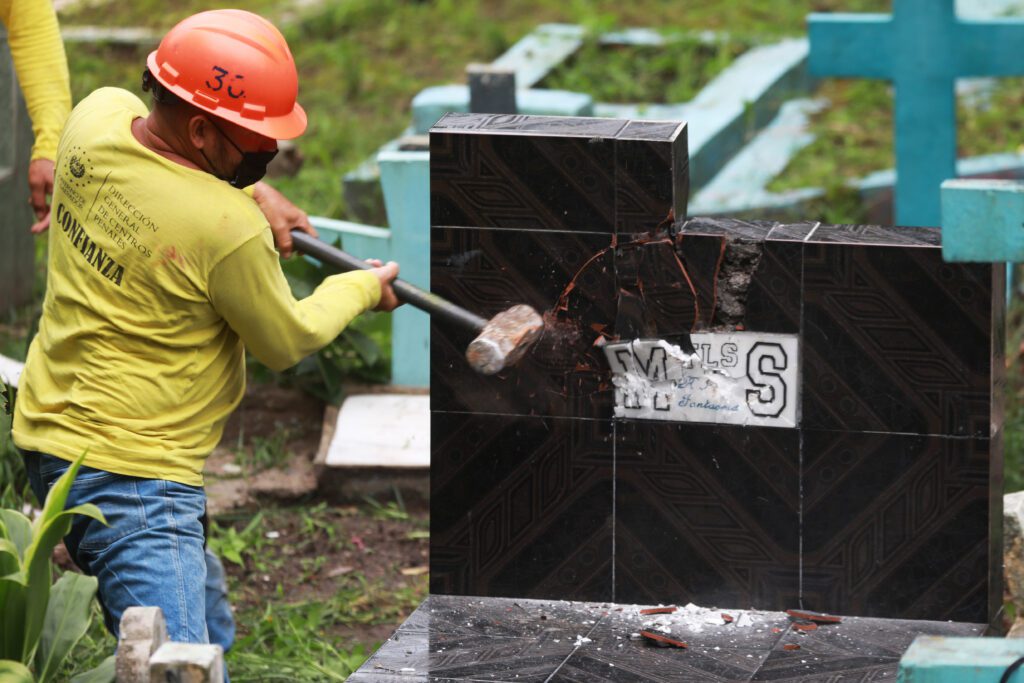
An inmate destroying a grave with symbology alluding to the Mara Salvatrucha (MS-13) gang at a cemetery in Santa Tecla, El Salvador, on November 3, 2022.
Photo: EL SALVADOR’S PRESIDENCY PRESS OFFICE / AFP
As if to mock the gang’s devotion to death and its once tyrannical hold on life in El Salvador, the government of this Central American country has been marching imprisoned members of the infamous MS-13 criminal organization to graveyards. There, the inmates take sledgehammers to any tombstone sporting the reeling gang’s insignias.
These symbols, now illegal in El Salvador, have become the target of a formidable wave of state-sponsored iconoclasm.
Mare Salvatrucha (MS-13) rose to prominence in the U.S., contributing to L.A.’s status as the country’s murder capital before a period of gang member deportations in the 1990s led to their increased presence back home in El Salvador, a country incapable of confronting the criminal threat at the time.
If Salvadorians founded the gang, however, Salvadorians are dismantling it. MS-13 is currently meeting with a juggernaut of law enforcement in their country’s present government, led by President Nayib Bukele.
Bukele launched his Territorial Control Plan in mid-2019, managing to cut the murder rate for 2020 in half compared to the preceding year.
Despite stringent anti-gang measures, the U.S. Treasury Department accused Bukele’s administration of negotiating with MS-13, a charge denied by the Salvadorian government (although there does now seem to be evidence that this did occur). The alleged negotiations, in any case, would have aimed to save Salvadorian lives, and would be part of a larger strategy to ultimately dismantle the criminal group.
Indeed, on the 27th of March 2022, the government asked El Salvador’s Legislative Assembly to declare a state of exception. This came on the heels of a dizzying slew of homicides, with 76 persons murdered in two days. Sweeping arrests followed, leading to the apprehension of 6,000 alleged gang members in ten days. New measures also included reprisals against imprisoned criminals, with Bukele warning MS-13 that if it retaliated for the crackdowns, their fellow gang members in prison would suffer the consequences, including losing mealtimes.
The state of emergency was effective in stemming this murder tide, with 2022 seeing a 56.8% decrease in homicides compared to 2021. A surge in public support for the government’s policy resulted, with a Gallup poll finding that 95% of Salvadorians approved the security measures. Measures which also elicited a contrasting backlash on the part of human rights groups, however, who have complained of excessive force and the erosion of civil liberties.
One prominent measure in the fight against MS-13 has been the construction of a new maximum security prison able to accommodate 40,000 inmates, which was finished on January 31st, 2023.
The origin and nature of MS-13 could be the subject of a longer exploration, placing the gang in the context of other Central American groups with similar features, including Mexican drug cartels. Indeed, the “13” in the group’s moniker refers to the 13th letter of the alphabet, representing the “M” in Mexican Mafia, under whose umbrella MS-13 operated in the U.S. prison system. It is therefore worth understanding this wider criminal ecosystem—a political ecosystem in which various organizations are joined together in relationships of vassalage. Generally, these share a common aesthetic and ideology, including overtly satanic imagery, as well as devotion to figures like Santa Muerte. Police investigations together with anthropological studies have revealed the prominence of bloody ritual and even cannibalism during gang initiations.
The gang phenomenon, therefore, transcends crime. Ultimately, gangs represent new, emergent tribes whose purpose is to swallow nations and compete with countries.
They display signs of tribal ethnogenesis, constituting an identity which tends to configure itself politically (all but running some regions of Mexico, for example). They are a mutant culture, an illegitimate identity, and have to be addressed as such.
Pseudo-religious features and the use of violence and degradation as a bonding agent and technology of control sheds light on certain ancient accounts of now-extinct cultures that practiced human sacrifice as part of their cultic observance. Likewise, it is interesting to reflect on historical (including Biblical) precedents for the iconoclastic destruction of images as a necessary civilizing measure, a means to purge a people from a thoroughly entrenched culture of dehumanization.
